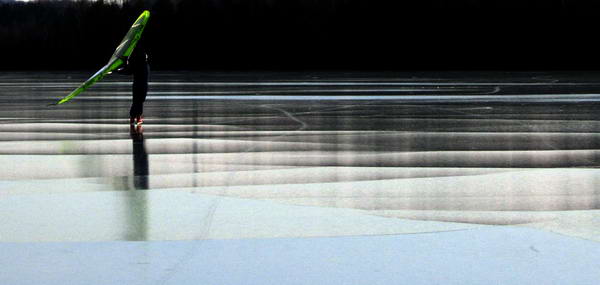Thermal Bending
 Contraction cracks running across the picture. The concave surfaces between the cracks are caused by thermal shrinkage of the cold ice on top of the ice sheet. Photo: Richard Saltonstall.
Contraction cracks running across the picture. The concave surfaces between the cracks are caused by thermal shrinkage of the cold ice on top of the ice sheet. Photo: Richard Saltonstall.
When ice cools it shrinks. As it shrinks it puts the sheet in tension (assuming it is bound to the shore). Ice is particularly weak in tension. Contraction cracks are more common in black ice less than a few inches thick. When the temperature drops late in the day the amount of noise new ice makes picks up. Contraction cracks make particular ‘poing’ when they form.
They are typically about ½” to one inch wide and are relatively straight. The stress field in the ice causes them to be parallel and (typically) 20-200 feet apart. They generally refreeze by morning. The next day, as the ice warms, with the crack filled with overnight ice the expansion of the overall sheet is taken up by pressure ridges in large lakes or elastic compression in small ones. The daily cycles of contracting, breaking, freezing and expanding into a ridge helps keeps the ridges active, wet and tricky to cross.
If there is blowing snow it catches in the crack and forms a long, low narrow water saturated drift. These drifts are usually a foot or two wide and an inch high but they can get to be several feet wide and a couple inches high. The slush typically freezes over night leaving a rough lumpy section. These have been named ‘Lava Lines’ by Vermont skaters. They are a major contributor to the roughening of pristine black ice for sailors and skaters.
Contraction Cracks are an excellent size for putting an iceboat runner or skate blade through with a high likelihood of a fall on skates and a moderate likelihood of tearing off a plank or a full crash in an iceboat. They do not seem to be a hazard for other ice users although the ice is obviously weaker at a free edge than in the middle of an intact sheet. The strength of an ice sheet with a wet crack in it is about half the strength without the crack.
